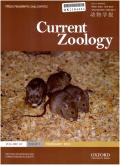藏羚羊的性别差异决策涉及早期阶段更快的新兵招募
IF 2
2区 生物学
Q2 ZOOLOGY
引用次数: 0
摘要
群居生活广泛存在于不同的类群中,在角色分工不同的情况下,集体决策的基本机制对于理解群体稳定性的动态变化至关重要。虽然对鱼类和昆虫等小型动物集体行为的研究已经非常成熟,但由于缺乏足够和系统的野外数据,对大型野生动物的类似研究仍然具有挑战性。在此,我们旨在通过分析个体领导力分布以及加入过程,并考虑产仔阶段和加入等级等因素,探讨中国西藏自治区二态藏羚羊(Pantholops hodgsonii)的集体决策模式及其性别差异。决策参与者的比例与群体大小和决策持续时间的明显相关性突出表明了决策准确性和速度之间的权衡。雄性羚羊表现出更民主的决策模式,而雌性羚羊在产犊初期后表现出更迅速的反应。这项研究揭示了藏羚羊的部分共同决策策略,表明群体决策过程的灵活自组织与动物生命周期的进展相一致。本文章由计算机程序翻译,如有差异,请以英文原文为准。
Sexually differentiated decision-making involves faster recruitment in the early stages for the Tibetan antelopes Pantholops hodgsonii
Group-living is widespread across diverse taxa, the mechanisms underlying collective decision-making in contexts of variable role division are critical for understanding the dynamics of group stability. While studies on collective behaviour in small animals such as fish and insects are well-established, similar research on large wild animals remains challenging due to the limited availability of sufficient and systematic field data. Here, we aimed to explore the collective decision-making pattern and its sexual difference for the dimorphic Tibetan antelopes Pantholops hodgsonii (chiru) in Xizang Autonomous Region, China, by analysing individual leadership distribution, as well as the joining process, considering factors such as calving stages and joining ranks. The distinct correlations of decision participants’ ratio with group size and decision duration underscore the trade-off between accuracy and speed in decision-making. Male antelopes display a more democratic decision-making pattern, while females exhibit more prompt responses after calving at early stage. This study uncovers a partially shared decision-making strategy among Tibetan antelopes, suggesting flexible self-organization in group decision processes aligned with animal life cycle progression.
求助全文
通过发布文献求助,成功后即可免费获取论文全文。
去求助
来源期刊

Current Zoology
Agricultural and Biological Sciences-Animal Science and Zoology
CiteScore
3.20
自引率
9.10%
发文量
111
审稿时长
6 weeks
期刊介绍:
About the Journal
Current Zoology (formerly Acta Zoologica Sinica, founded in 1935) is an open access, bimonthly, peer-reviewed international journal of zoology. It publishes review articles and research papers in the fields of ecology, evolution and behaviour.
Current Zoology is sponsored by Institute of Zoology, Chinese Academy of Sciences, along with the China Zoological Society.
 求助内容:
求助内容: 应助结果提醒方式:
应助结果提醒方式:


